Two pence (British decimal coin)
Last updatedUnited Kingdom (UK) | |
| Value | £0.02 |
|---|---|
| Mass | 7.12 g |
| Diameter | 25.9 mm |
| Thickness | |
| Edge | Plain |
| Composition |
|
| Years of minting | 1971–present |
| Obverse | |
 | |
| Design | Queen Elizabeth II |
| Designer | Jody Clark |
| Design date | 2015 |
| Reverse | |
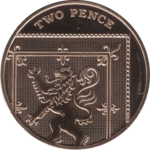 | |
| Design | Segment of the Royal Shield |
| Designer | Matthew Dent |
| Design date | 2008 |
The British decimal two pence coin (often shortened to 2p in writing and speech) is a denomination of sterling coinage equalling 2⁄100 of a pound. Since the coin's introduction on 15 February 1971, the year British currency was decimalised, its obverse has featured four profiles of Queen Elizabeth II. [1] In 2008 the design on its reverse changed from the original depiction of a plume of ostrich feathers with a coronet to a segment of the Royal Shield.
Contents
The two pence coin was originally minted from bronze, but changed in 1992 to copper-plated steel.
As of March 2014 there were an estimated 6.55 billion 2p coins in circulation corresponding to a value of £131 million. [2]
Two pence coins are legal tender for amounts only up to the sum of 20p when offered in repayment of a debt; however, the coin's legal tender status is not normally relevant for everyday transactions.[ citation needed ]
Composition
From its first minting in 1971 until 1992, two pence coins were made from bronze. In 1992, this was changed to copper-plated steel because of the increasing price of copper used to make bronze. [3] Both the bronze and steel versions were made in 1992 only.
By May 2006 the pre-1992 (97% copper) coins contained 3p worth of copper each. [4] In May 2006, about 2.55 billion such coins remained in circulation, [4] and the Royal Mint warned that tampering with coinage is illegal in the UK. [5] During 2008, the value of copper fell dramatically from these peaks. [6]
Design

Reverse
The original reverse of the coin, designed by Christopher Ironside, and used from 1971 to 2008, is the Badge of the Prince of Wales: a plume of ostrich feathers within a coronet, above the German motto ICH DIEN ("I serve"). The numeral "2" is written below the badge, and either NEW PENCE (1971–1981) or TWO PENCE (from 1982) is written above. A small number of 1983 mintage coins exist with the "New Pence" wording. It was originally planned that an alternative version of the 2p would be minted with a design representing Northern Ireland; [7] these plans never came to fruition. The same design was also re-cut in 1993 producing two minor varieties for that year. [8]
In August 2005 the Royal Mint launched a competition to find new reverse designs for all circulating coins apart from the £2 coin. [9] The winner, announced in April 2008, was Matthew Dent, whose designs were gradually introduced into the circulating British coinage from mid-2008. [10] The designs for the 1p, 2p, 5p, 10p, 20p and 50p coins depict sections of the Royal Shield that form the whole shield when placed together. The shield in its entirety was featured on the now-obsolete round £1 coin. The re-designed 2p coin depicts the second quarter of the shield, showing the Lion Rampant from the Royal Banner of Scotland, with the words TWO PENCE above.
The beading was removed from both sides of the coin in the 2008 re-design.
In October 2023 the King Charles III two-pence coin was presented; the coin features a red squirrel. [11] [12]
Obverse
To date, five different obverses have been used: four different portraits and the removal of the beaded border in 2008. [8] In all cases, the inscription is ELIZABETH II D.G.REG.F.D. 2013, [8] where 2013 is replaced by the year of minting. In the original design both sides of the coin are encircled by dots, a common feature on coins, known as beading.
Four different portraits of the Queen have been used on the coin:
- As with all new decimal currency, until 1984 the portrait of Queen Elizabeth II by Arnold Machin appeared on the obverse, [13] in which the Queen wears the 'Girls of Great Britain and Ireland' Tiara.
- Between 1985 and 1997 the portrait by Raphael Maklouf was used, [13] in which the Queen wears the George IV State Diadem. In 1992 the metal used in minting this coin was switched from bronze to copper-plated steel, with a single year of using both alloys in 1998. [3]
- From 1998 to 2015 the portrait by Ian Rank-Broadley was used, [13] again featuring the tiara, with a signature-mark IRB below the portrait.
- As of June 2015, coins bearing the portrait by Jody Clark have been seen in circulation.
Mintages
| Year | Number minted | Composition | Portrait | Reverse |
|---|---|---|---|---|
| 1971 | 1,454,856,250 | Bronze | Machin | Ironside |
| 1972 | In sets only | |||
| 1973 | In sets only | |||
| 1974 | In sets only | |||
| 1975 | 145,545,000 | |||
| 1976 | 181,379,000 | |||
| 1977 | 109,281,000 | |||
| 1978 | 189,658,000 | |||
| 1979 | 260,200,000 | |||
| 1980 | 408,527,000 | |||
| 1981 | 353,191,000 | |||
| 1982 | In sets only | |||
| 1983 | In sets only | |||
| 1984 | In sets only | |||
| 1985 | 107,113,000 | Maklouf | ||
| 1986 | 168,967,500 | |||
| 1987 | 218,100,750 | |||
| 1988 | 419,889,000 | |||
| 1989 | 359,226,000 | |||
| 1990 | 204,499,700 | |||
| 1991 | 86,625,250 | |||
| 1992 | 102,247,000 | |||
| Copper-plated steel | ||||
| 1993 | 235,674,000 | |||
| 1994 | 531,628,000 | |||
| 1995 | 124,482,000 | |||
| 1996 | 296,278,000 | |||
| 1997 | 496,116,000 | |||
| 1998 | 98,676,000 | Bronze | Rank-Broadley | |
| 115,154,000 | Copper-plated steel | |||
| 1999 | 353,816,000 | |||
| 2000 | 563,659,000 | |||
| 2001 | 551,880,000 | |||
| 2002 | 168,556,000 | |||
| 2003 | 260,225,000 | |||
| 2004 | 356,396,000 | |||
| 2005 | 280,396,000 | |||
| 2006 | 170,637,000 | |||
| 2007 | 254,500,000 | |||
| 2008 | 10,600,000 | |||
| 241,679,000 | Dent | |||
| 2009 | 150,500,500 | |||
| 2010 | 99,600,000 | |||
| 2011 | 144,300,000 | |||
| 2012 | 67,800,000 | |||
| 2013 | 40,600,000 | |||
| 2014 | 247,600,020 | |||
| 2015 | 85,900,000 | |||
| 2015 | 139,200,000 | Clark | ||
| 2016 | 185,600,000 | |||
| 2017 | 16,600,000 | |||
| 2018 | 0 | |||
| 2019 | 0 | |||
| 2020 | 0 | |||
| 2021 | 117,700,000 | |||
| 2022 | 0 |
Mint Sets have been produced since 1982; where mintages on or after that date indicate 'none', there are examples contained within those sets.
Related Research Articles

The standard circulating coinage of the United Kingdom, British Crown Dependencies and British Overseas Territories is denominated in pennies and pounds sterling, and ranges in value from one penny sterling to two pounds. Since decimalisation, on 15 February 1971, the pound has been divided into 100 (new) pence. Before decimalisation, twelve pence made a shilling, and twenty shillings made a pound.
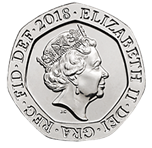
The British decimal twenty pence coin is a denomination of sterling coinage worth 1⁄5 of a pound. Like the 50p coin, it is an equilateral curve heptagon. Its obverse has featured the profile of Queen Elizabeth II since the coin's introduction on 9 June 1982. Four different portraits of the Queen have been used; the latest design by Jody Clark was introduced in 2015. The second and current reverse, featuring a segment of the Royal Shield, was introduced in 2008.
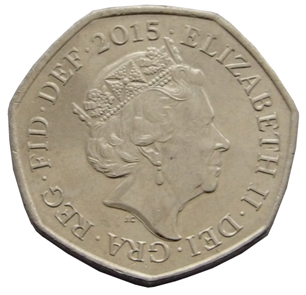
The British decimal fifty pence coin is a denomination of sterling coinage worth 1⁄2 of one pound. Its obverse features the profile of the current Monarch since the coin's introduction in 1969. As of October 2022, five different royal portraits have been used.
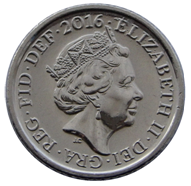
The British decimal five pence coin is a denomination of sterling coinage worth 5⁄100 of a pound. Its obverse has featured the profile of Queen Elizabeth II since the coin’s introduction on 23 April 1968, replacing the shilling in preparation for decimalisation in 1971. It remained the same size as the one shilling coin, which also remained legal tender, until a smaller version was introduced in June 1990 with the older coins being withdrawn on 31 December 1990. Four different portraits of the Queen have been used, with the latest design by Jody Clark being introduced in 2015. The second and current reverse, featuring a segment of the Royal Shield, was introduced in 2008.

The British decimal ten pence coin is a denomination of sterling coinage worth 1⁄10 of a pound. Its obverse has featured the profile of Queen Elizabeth II since the coin's introduction in 1968, to replace the florin coin in preparation for decimalisation in 1971. It remained the same size as the florin coin until a smaller version was introduced 30 September 1992, with the older coins being withdrawn on 30 June 1993. Four different portraits of the Queen have been used on the coin; the latest design by Jody Clark was introduced in 2015. The second and current reverse, featuring a segment of the Royal Shield, was introduced in 2008.
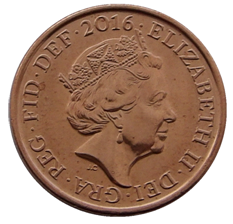
The British decimal one penny (1p) coin is a unit of currency and denomination of sterling coinage worth 1⁄100 of one pound. Its obverse featured the profile of Queen Elizabeth II since the coin's introduction on 15 February 1971, the day British currency was decimalised until her death on 8 September 2022. A new portrait featuring King Charles III was introduced on 30 September 2022, designed by Martin Jennings. Four different portraits of the Queen were used on the obverse; the last design by Jody Clark was introduced in 2015. The second and current reverse, designed by Matthew Dent, features a segment of the Royal Shield and was introduced in 2008. The penny is the lowest value coin ever to circulate in the United Kingdom.

The British decimal halfpenny coin was a denomination of sterling coinage introduced in February 1971, at the time of decimalisation, and was worth 1⁄200 of one pound. It was ignored in banking transactions, which were carried out in units of 1p.

The British two pound coin (£2) is a denomination of sterling coinage. Its obverse has featured the profile of Queen Elizabeth II since the coin’s introduction. Three different portraits of the Queen have been used, with the current design by Jody Clark being introduced in 2015. The reverse design features Britannia.

The British one pound (£1) coin is a denomination of sterling coinage. Its obverse bears the Latin engraving ELIZABETH II D G REG F D meaning, 'Elizabeth II, by the grace of God, Queen, Defender of the Faith'. It has featured the profile of Queen Elizabeth II since the original coin's introduction on 21 April 1983. Four different portraits of the Queen have been used, with the latest design by Jody Clark being introduced in 2015. The design on the reverse side of the current, 12-sided coin features four emblems to represent each of the nations of the United Kingdom — the English rose, the leek for Wales, the Scottish thistle, and the shamrock for Northern Ireland, also two or three oak leaves — emerging from a single 5-branched stem within a crown. In May 2022 the Royal Mint announced that the Kenyan-born artist Michael Armitage is designing a new £1 coin which will be issued in 2023 and will celebrate the "history of the UK in the 21st century".

The British penny, a large, pre-decimal coin which continued the series of pennies which began in about the year 700, was struck intermittently during the 20th century until its withdrawal from circulation after 1970. From 1901 to 1970, the obverse of the bronze coin depicted the monarch who was reigning at the start of the year. The reverse, which featured an image of Britannia seated with shield, trident, and helm, was created by Leonard Charles Wyon based on an earlier design by his father, William Wyon. The coins were also used in British colonies and dominions that had not issued their own coins.

The British florin, or two-shilling piece, was a coin worth 1⁄10 of one pound, or 24 pence. It was issued from 1849 until 1967, with a final issue for collectors dated 1970. It was the last coin circulating immediately prior to decimalisation to be demonetised, in 1993, having for a quarter of a century circulated alongside the ten-pence piece, identical in specifications and value.

The British pre-decimal halfpenny,, once abbreviated ob., was a denomination of sterling coinage worth 1/480 of one pound, 1/24 of one shilling, or 1/2 of one penny. Originally the halfpenny was minted in copper, but after 1860 it was minted in bronze. In the run-up to decimalisation, it ceased to be legal tender from 31 July 1969. The halfpenny featured two different designs on its reverse during its years in circulation. From 1672 until 1936 the image of Britannia appeared on the reverse, and from 1937 onwards the image of the Golden Hind appeared. Like all British coinage, it bore the portrait of the monarch on the obverse.

The British threepence piece, usually simply known as a threepence, thruppence, or thruppenny bit, was a denomination of sterling coinage worth 1⁄80 of one pound or 1⁄4 of one shilling. It was used in the United Kingdom, and earlier in Great Britain and England. Similar denominations were later used throughout the British Empire and Commonwealth countries, notably in Australia, New Zealand and South Africa.

Decimal Day in the United Kingdom and in Ireland was Monday 15 February 1971, the day on which each country decimalised its respective £sd currency of pounds, shillings, and pence.

Coins of the Indian rupee (₹) were first minted in 1950. New coins have been produced annually since then and they make up a valuable aspect of the Indian currency system. Today, circulating coins exist in denominations of One Rupee, Two Rupees, Five Rupees, Ten Rupees and Twenty Rupees. All of these are produced by four mints located across India, in Kolkata, Mumbai, Hyderabad, Noida.

The British sixpence piece, sometimes known as a tanner or sixpenny bit, was a denomination of sterling coinage worth 1⁄40 of one pound or half of one shilling. It was first minted in 1551, during the reign of Edward VI, and circulated until 1980. The coin was made from silver from its introduction in 1551 until 1947, and thereafter in cupronickel.

Christopher Ironside OBE, FRBS was an English painter and coin designer, particularly known for the reverse sides of the new British coins issued on decimalisation in 1971.
The coins of the Australian dollar were introduced on 14 February 1966, although they did not at that time include the one-dollar or two-dollar coins. The dollar was equivalent in value to 10 shillings in the former currency.

The shilling, informally called a "bob", was a type of silver coinage issued by the Commonwealth of Australia, that circulated prior to the decimalisation of Australian coinage. The Australian shilling was derived from the British pre-decimal sterling pound system and was first issued following the passing of the Australian Coinage Act 1909, which established Australia's first formal currency system. The shilling was issued as part of Australia's silver coinage, which included the two-shilling (florin), the sixpence and the threepence. The shilling was minted from 1910 until 1963. During this period there was one significant modification to the design of the Australian shilling, the change in its reverse design, which occurred in 1938 when the design was altered from the Australian coat of arms (1910–1936) to the visage of a Merino ram's head (1938–1963).

The Australian sixpence circulated from 1910 up until the decimalisation of Australian Currency in 1966. The coins were initially minted in England; however, Australia began to mint their own from the year of 1916 at branches of the Royal Mint in Sydney and Melbourne. The coins which made up Australia's pre-decimal currency were identical to British currency in the characteristics of weight and size. The Coinage Act of 1909–1947, authorised the issue of Australian coins in the select denominations, including the sixpence. By 1916 all silver denominations, including the sixpence, could be minted at the Royal Mint branch in Melbourne. Unique Australian currency was created with decimalisation in 1966.
References
- ↑ Bignell, C P. "Post decimalisation" . Retrieved 2006-05-23.
- ↑ "Mintage Figures". Royal Mint. Retrieved 28 December 2015.
- 1 2 "2p Coin Designs and Specifications | The Royal Mint". www.royalmint.com. Retrieved 2022-01-08.
- 1 2 "Your small fortune: 2p coins that could be worth 3p each", Telegraph, 12 May 2006
- ↑ "Mint warns against melting coins", BBC News, 12 May 2006
- ↑ London Metal Exchange copper price graphs Archived 2008-11-07 at the Wayback Machine
- ↑ "50 New Penny Piece", Hansard, 20 December 1968
- 1 2 3 Clayton, Tony. "Decimal Coins of the UK – Two Pence" . Retrieved 2015-01-18.
- ↑ "Royal Mint seeks new coin designs", BBC News, 17 August 2005
- ↑ "Royal Mint unveils new UK coins" Archived 2008-09-07 at the Wayback Machine , 2 April 2008
- ↑ BBC
- ↑ The Royal Mint
- 1 2 3 "1p Coin". British Royal Mint. Archived from the original on 2006-04-27. Retrieved 2006-05-23.
- ↑ "2p Two Pence Mintage Figures". www.royalmint.com. Retrieved 2023-09-02.
External links
Text is available under the CC BY-SA 4.0 license; additional terms may apply.
Images, videos and audio are available under their respective licenses.